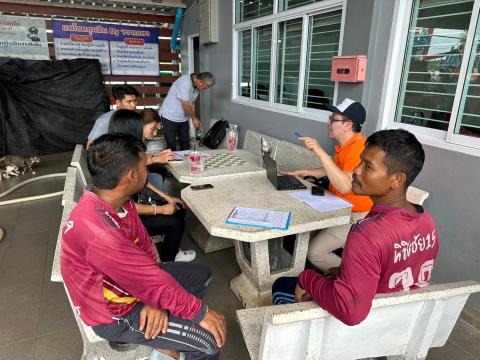Mangroves and Shrimp - a Litmus Test for Food System Transformation - Jan '25
Friday 10th January 2025
- Mangroves are critical to the green transition: sucking down carbon, reducing flood risk and sustaining coastal communities.
- For decades our food system has led to mangrove deforestation across the globe, with shrimp farming driving much of the destruction.
- Two major shrimp exporters – Thailand and Ecuador – are proving it’s possible to delink shrimp supply from mangrove destruction, showing the way for other commodities and regions.
With Brazil hosting COP30 in the heart of the Amazon rainforest in 2025, nature, food and deforestation will be high on the agenda for policymakers, investors and companies.
Mangroves – alongside terrestrial forests – must be central to their thinking.
Mangroves connect land and sea. They are vital biodiversity hotspots, home to hundreds of threatened species and supporting the livelihoods of millions of people around the world by providing food and extreme whether protection. They are also a vast carbon sink storing up to five times more carbon per acre than rainforests.
Yet, since 1996, unsustainable practices in the food system have contributed to the destruction of over one million hectares of mangroves. And, despite their immense potential, mangrove protection and restoration receives only ~1% of climate finance today.
The good news? Transformation is proving possible and profitable with leadership emerging, restoration increasing and a clearer path forward for other commodities and regions across the food system.
Shrimp farming has, in many countries around the world, disconnected itself from mangrove destruction.
New data collected from geospatial monitoring technology shows there is now almost zero conversion of mangroves in two of the major shrimp exporters in the global market: Thailand and Ecuador.
In Thailand, the Seafood Task Force has been bringing the shrimp supply chain and broader stakeholder universe together for the past 10 years to unblock systemically significant challenges that seemed initially intractable. And through collaboration – from vessel to plate, from feed supplier, to farmer, to processor, to retailer and government – new solutions have been developed to, for example, enable extensive electronic traceability to strengthen accountability.
Action has been driven on the ground so farmers are empowered to make changes – a leading Thai shrimp processor told us, “we try to understand why people do things the way they do and not to tell them … the farmer must want to make the changes themselves. That’s the only way of making sustainable change”. And the system has aligned behind a new commercial rationale premised on the often-hidden value of confidence. The Seafood Task Force’s moto is “confidence to trade” – the aim is to give industry buyers of seafood confidence that the supply chain is ready to face the rising tide of policy and stakeholder expectations.

Switch across the globe to Ecuador and you’ll find the largest mangrove forests in the Western hemisphere, and a $7.4bn shrimp industry.
The Chamber of Aquaculture, and the 400 companies it represents from the entire shrimp value chain, committed to ending habitat conversion from shrimp farming with WWF-Ecuador, making Ecuador the first nation to commit to conversion free aquaculture.
Together with WWF and the Sustainable Shrimp Partnership, the Chamber of Aquaculture tackled the data challenge by working with Clark University to map mangrove forests in Ecuador starting 10 km from the continental coastline to track destruction and restoration.
With data increasingly available, industry has pushed government to extend farming prohibition to mangrove forests, so the only way to expand or build a farm is to grow in areas not near mangrove forests. New solutions are now making the transition increasingly economic for farmers: the Climate Smart Shrimp fund has been successfully piloted by Conservation International and xpertSea to provide loan packages that enable farmers to adopt sustainable and efficient production systems while restoring mangrove ecosystems. Ecuador’s Sustainable Shrimp Partnership and its member companies have been the first to pioneer and adopt Blockchain technology to enable extensive traceability.
What next? Attention is focused on significant mangrove restoration and tackling other threats to the mangrove ecosystem, like saltwater intrusion.
Thailand and Ecuador prove that systemic transformation is possible, and it can be profitable when transformation is done in partnership with – not to – the stakeholder universe. We’re seeing positive trends in the data with mangrove restoration efforts and mangrove growth increasing coverage.
Action continues apace in Thailand and Ecuador, and critically, they show the way for other commodities and regions. After decades working across the industry and environmental sustainability, five learnings stand out to us:
- Radical collaboration across the value chain – including with farmers on the ground – sets the foundation for sustainable transformation and impact;
- Clear government conservation mandates accelerate progress unlike anything else;
- Active engagement from major retailers enables action that supports commercial success;
- Public and private finance is and will continue to be critical for transformation to achieve the goals outlined by the Mangrove Breakthrough;
- There is always a new frontier – it was ending mangrove destruction, now it is mangrove restoration; continuous improvement is the only way to long term resilience.
The food system is uniquely complex – but as Thailand and Ecuador show, it is transformable. Now, it’s over to other commodities, supply chains and regions around the world to rise to the challenge.